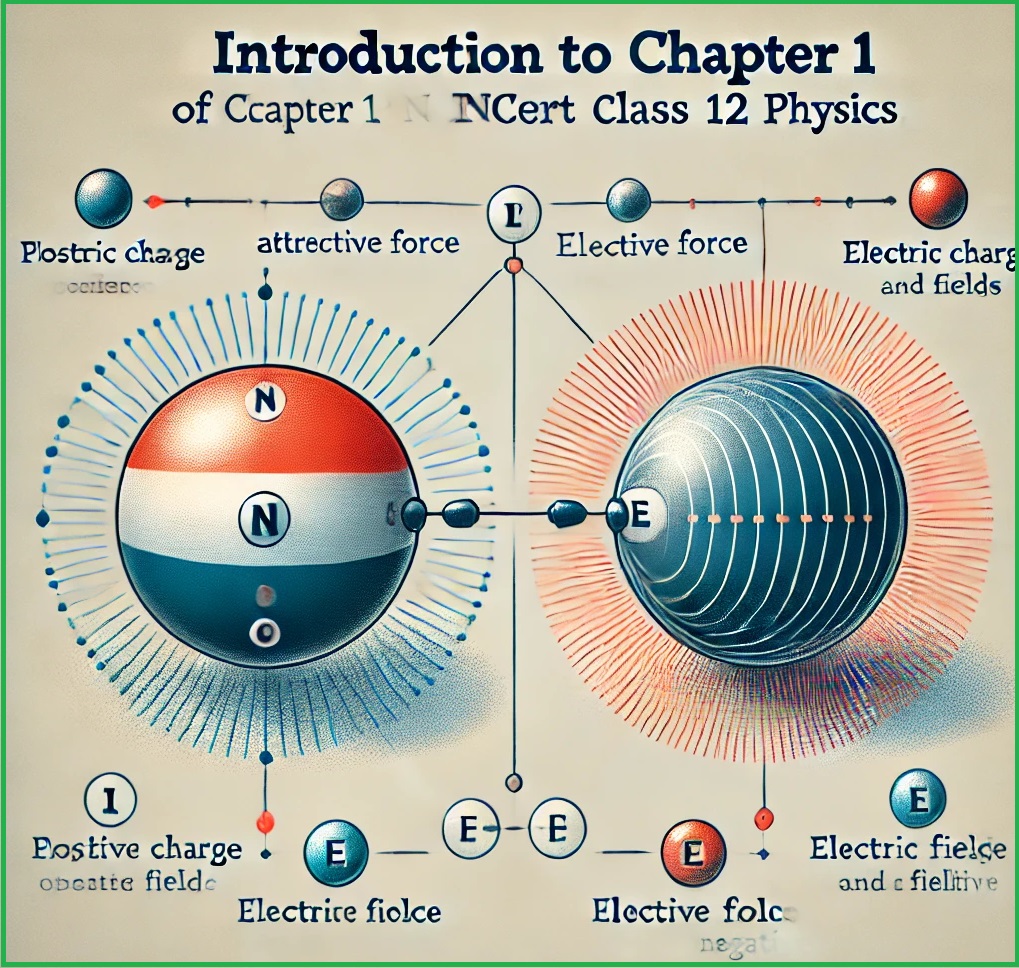
Here’s a summary of the key ideas covered in this introduction:
- Electric Charge:
- Electric charge is a property of subatomic particles like electrons and protons. It exists in two types: positive and negative.
- The discovery of electric charge helps explain various phenomena in nature, like lightning, and forms the basis for understanding electricity and magnetism.
- Basic Properties of Charge:
- Charges of the same type repel each other, while opposite charges attract.
- Charge is conserved, meaning it cannot be created or destroyed; it only transfers from one body to another.
- Electric charge is quantized, meaning it exists in discrete amounts (e.g., multiples of the electron’s charge).
- Electrostatic Force and Coulomb’s Law:
- The introduction briefly mentions Coulomb’s law, which quantifies the electrostatic force between two charges. This force is directly proportional to the product of the magnitudes of the charges and inversely proportional to the square of the distance between them.
- Applications and Importance:
- Understanding electric charges and fields is crucial for explaining phenomena like lightning and the forces within atoms. It also forms the basis for electrical and electronic technology, influencing fields like telecommunications, energy, and computing.
The Introduction sets up the chapter to explore these concepts in depth, including the electric field, potential, and the behavior of charges in different materials. This foundation in electrostatics is essential for progressing through other topics in physics, such as current electricity, magnetism, and electromagnetism.
Index NCERT 12th Class Physics
Electrostatic Potential and Capacitance
- lectrostatic Potential and Potential Difference
- Potential due to a Point Charge, Dipole
- Potential due to Systems of Charges
- Equipotential Surfaces
- Electrostatic Potential Energy
- Conductors and Dielectrics in Electrostatic Field
- Capacitance, Parallel Plate Capacitor, and its Combination
Current Electricity
- Electric Current, Drift Velocity
- Mobility and Limitations of Ohm’s Law
- Resistivity and its Temperature Dependence
- Combination of Resistors - Series and Parallel
- Kirchhoff’s Laws, Wheatstone Bridge
- Meter Bridge and Potentiometer
Moving Charges and Magnetism
- Magnetic Force
- Motion in Magnetic and Electric Fields
- Biot-Savart Law and its Application
- Ampere’s Circuital Law
- Solenoid and Toroid
- Force between Parallel Conductors
- Moving Coil Galvanometer
Magnetism and Matter
- Introduction to Magnetic Fields and Earth’s Magnetism
- Magnetic Properties of Materials
- Diamagnetism, Paramagnetism, and Ferromagnetism
- Hysteresis, Magnetic Hysteresis, and B-H Curve
- Permanent Magnets and Electromagnets
Electromagnetic Induction
- Introduction and Faraday’s Law
- Lenz’s Law and Conservation of Energy
- Motional Electromotive Force
- Eddy Currents and Self-Induction
- AC Generator and Transformer
Alternating Current
- AC Voltage Applied to Resistor, Inductor, and Capacitor
- Series LCR Circuit and Resonance
- Power in AC Circuit
- Power Factor, LC Oscillations
- Transformers and Electrical Power Transmission
Electromagnetic Waves
- Introduction and Displacement Current
- Electromagnetic Waves and their Characteristics
- Electromagnetic Spectrum - Radio, Microwaves, Infrared, Visible, UV, X-rays, Gamma Rays
Ray Optics and Optical Instruments
- Reflection, Refraction, and Dispersion
- Total Internal Reflection, Optical Fibres
- Refraction at Spherical Surfaces
- Lenses, Lens Maker’s Formula
- Magnification, Power of Lens
- Microscope and Telescope
Wave Optics
- Huygens’ Principle
- Interference of Light Waves
- Young’s Double Slit Experiment
- Diffraction and Polarization of Light
Dual Nature of Radiation and Matter
- Introduction to Electron Emission
- Photoelectric Effect and its Experimental Study
- Einstein’s Photoelectric Equation
- Particle Nature of Light, Wave Nature of Matter
- de Broglie Hypothesis
Atoms
- Alpha-Particle Scattering and Rutherford’s Nuclear Model
- Atomic Spectra, Bohr Model of Hydrogen Atom
- Energy Levels, Line Spectra, and Hydrogen Spectrum
Nuclei
- Nuclear Size and Density
- Mass-Energy Relation, Binding Energy Curve
- Nuclear Fission and Fusion
- Radioactivity: Alpha, Beta, and Gamma Decays
Semiconductor Electronics: Materials, Devices, and Simple Circuits
- Intrinsic and Extrinsic Semiconductors
- p-n Junction and its Characteristics
- Junction Diode as a Rectifier
- Special Purpose Diodes - LED, Photodiode, Solar Cell
- Transistors, Logic Gates
Communication Systems
- Elements of a Communication System
- Bandwidth of Signals
- Propagation of Electromagnetic Waves
- Modulation and Demodulation, Amplitude and Frequency Modulation






